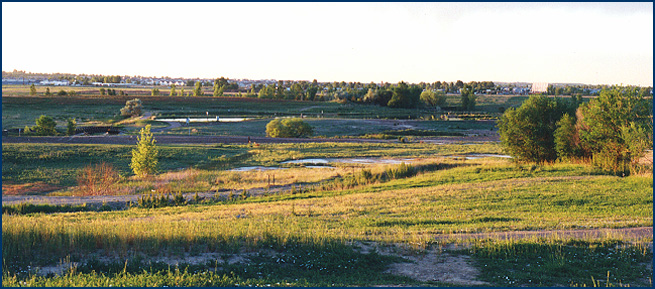

In this huge metro area, where can you find pools of darkness? There are a few left, but they are shrinking, tens of acres at a time, filling with chock-a-block houses or streams of commercial buildings. Westminster has one such treasure. It's called Big Dry Creek. In these dry plains, it's a stream that has been engineered as a canal, but still left to wind its way bordered by willows and cottonwoods and tall cutaway banks that hold bank swallow nests.
I know the sections that run from 112th Street, behind Front Range Community College, under the intersection of Federal Boulevard and 120th Street, and along the base of the ridge north of 120th to 128th Street. At night, looking west from Federal Boulevard north of 112th, the view is filled with a large, velvety pool of darkness, whose lack of light is accentuated by the ring of lights surrounding it.
Houses have not crowded in next to the trail that runs along the Creek, and there is a large swath of open space reaching from behind the College to 120th. I met a coyote which had come across the field near 120th one morning. It stopped and then turned and angled back across the weed-filled field. The winter before last, a grain crop grew there, but it's been weeds since summer. A fitness center and a restaurant have paved over one section. Another section has the look of being built on next. And I read not long ago that Westminster is planning a school at the south side of 120th where Lowell now ends, in a place which harbors a clean-limbed dead tree, a favorite perch for the wintering bald eagles that have inhabited the creek these past two winters.
I know that planners and developers in this place do not value big pools of darkness. Places where there are no street lights, no house lights, no glitz of commerce, where no human makes a profit except in the spirit. Places where the wild inhabitants can find space to nest, to hunt, to burrow, bothered only by the wild hunters themselves and by the dogs that are let off leash and chase the prairie dogs and the rabbits. Where even the loud and constant hum of traffic doesn't seem to bother them as much as it does me.
The commercial development marches eastward along 120th from Sheridan, covering over field after field, and quarter million dollar houses push eastward from Sheridan along a new section of 117th. Office buildings and houses begin to crawl down the side of the ridge behind the Moorish arches of the Arabian horse headquarters on 120th. What will be left to create that sense of wonderful open space that currently is felt along these sections of Big Dry Creek? Do the city planners truly believe that a narrow ribbon of trail and creek will be sufficient for all the human users, much less the non-human ones?
Right now, harrier hawks float over the fields and the unplowed prairie landscape. Ferruginous hawks perch on old fence posts. Rough-legged and red-tailed hawks are always hunting. Eagles spend two to three months in the winter dining on prairie dogs, applying some natural checks to the numerous "towns" that border the creek. Meadowlarks and red-winged blackbirds are there all year, soon to be singing their melodious warbles of springtime and summer. Great blue herons and black-crowned night herons frequent the ponds. Pelicans fly along the creek, and killdeer raise their young among the prairie dogs.
What is the minimum needed to keep these wildlife populations healthy? Does anyone truly care about the wildlife or are the trails just for human exercise?
Where will the people around Big Dry Creek find a place to rest their spirit from the madness of this urban area? Will it be along what will be left of the strip of open space along Big Dry Creek, no longer a big pool of darkness but a mere narrow strip? Not nearly enough, I say. Not nearly enough to bring that touch of the wild to the neighboring human inhabitants desperately hungering for something which they may not even know they have lost.
Table of Contents
Letter to the Author: